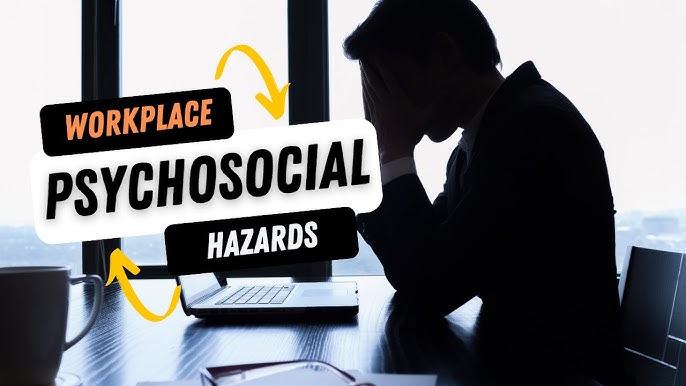In today’s complex work environments, psychosocial hazards—factors that affect employees’ psychological health and well-being—are increasingly recognized as significant influences on workplace productivity, morale, and overall organizational health. These hazards include work-related stress, bullying, harassment, job insecurity, excessive workloads, and lack of autonomy. Research from Harvard, Oxford, and the World Health Organization (WHO) has illuminated the profound effects these hazards have on employees and organizations alike, emphasizing the need for proactive management and support systems.
Understanding Psychosocial Hazards
Psychosocial hazards refer to aspects of work design, organization, and management that have the potential to cause psychological or social harm. Unlike physical hazards, these are less tangible but equally impactful, affecting mental health, job satisfaction, and productivity. The WHO defines psychosocial risks as the interactions among job content, work organization, and environmental conditions, all of which influence employees’ health, performance, and well-being.
Key psychosocial hazards identified by researchers and mental health organizations include:
- Excessive workload and time pressure
- Job insecurity
- Lack of autonomy and control
- Inadequate managerial support
- Unclear job roles and responsibilities
- Poor workplace relationships (e.g., bullying and harassment)
Harvard and Oxford Studies on the Impact of Psychosocial Hazards
Research conducted by Harvard Business School and the Oxford University Department of Psychiatry underscores the significant effects of psychosocial hazards on both individuals and organizations. For instance, a study from Harvard Business Review (HBR) highlighted that excessive stress levels in the workplace can lead to a 50% increase in voluntary turnover, costing companies millions in recruitment, training, and lost productivity.
Oxford University’s Department of Psychiatry has also extensively studied the impact of job-related stress and mental health on productivity. A landmark study found that employees experiencing high levels of workplace stress or burnout were significantly less productive and more likely to experience chronic health conditions. The Oxford researchers concluded that mental health directly influences an individual’s motivation, efficiency, and long-term health, leading to increased absenteeism and presenteeism in organizations.
WHO’s Findings on Psychosocial Hazards
The WHO has identified workplace stress as a leading cause of mental health disorders, contributing to conditions such as anxiety, depression, and cardiovascular disease. In its “World Mental Health Report,” the WHO highlights that untreated mental health issues stemming from workplace stressors result in lost productivity worth an estimated $1 trillion annually across the global economy. Furthermore, the WHO’s “Guidelines on Mental Health at Work” emphasize the need for psychosocial risk management as a core part of occupational health and safety, underscoring that mental health and well-being should be prioritized alongside physical safety.
The Ripple Effect on Organizations
The implications of psychosocial hazards extend beyond individual health and productivity. They impact team dynamics, organizational culture, and even bottom-line performance. Harvard researchers found that workplaces characterized by high-stress environments are often marked by lower levels of teamwork and higher rates of conflict, creating a pervasive cycle that reduces overall morale and engagement. When employees feel undervalued, overworked, or unsupported, the cumulative stress impacts decision-making, innovation, and customer satisfaction.
Oxford research further shows that high-stress environments are counterproductive for fostering creativity and problem-solving—skills essential for knowledge-based work. This not only stifles employee growth but can also hinder an organization’s adaptability and competitiveness in fast-paced markets.
Proactive Management of Psychosocial Hazards
- Policy Development and Training: Organizations should incorporate mental health and psychosocial hazard management into workplace policies. WHO guidelines recommend that these policies include clear processes for reporting and addressing psychosocial risks, fostering a supportive culture. Additionally, training programs, like those provided by Diversity Australia, help employees recognize and manage stress and equip managers with the skills to support team members effectively.
- Fostering a Culture of Support and Inclusion: Harvard’s research underscores the role of supportive leadership in reducing workplace stress. Managers who regularly check in with employees, provide constructive feedback, and create a sense of psychological safety contribute to healthier work environments. By cultivating a culture where employees feel valued and supported, organizations can minimize stress and create a resilient workforce.
- Providing Resources and Access to Mental Health Support: Organizations can offer mental health resources, including Employee Assistance Programs (EAPs), stress management workshops, and mindfulness sessions. WHO research suggests that these resources not only support individual mental health but can also improve workplace morale and productivity.
- Implementing Flexible Work Arrangements: Oxford studies highlight the importance of flexible work arrangements in reducing stress. Flexibility in work hours and location can alleviate time pressure, improve work-life balance, and reduce the risk of burnout.
The evidence is clear: psychosocial hazards have profound and lasting effects on both employees and organizations. Research from Harvard, Oxford, and the WHO reveals that proactively managing these hazards is essential for promoting mental well-being, enhancing productivity, and maintaining a positive organizational culture. By implementing policies, fostering supportive leadership, and providing access to mental health resources, organizations can create safer, healthier, and more productive workplaces.
As organizations across the globe continue to recognize the importance of mental health, integrating psychosocial risk management into workplace practices will remain a critical factor in achieving sustainable success and resilience. In a rapidly changing work environment, a commitment to addressing psychosocial hazards is not only beneficial but essential for long-term organizational health.




